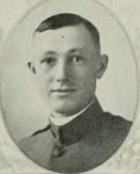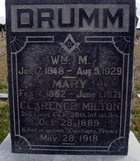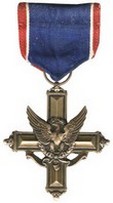Milt Drumm
| Date and Place of Birth: | October 28, 1889 Bigelow, KS |
| Date and Place of Death: | May 28, 1918 Cantigny, France |
| Baseball Experience: | Minor League |
| Position: | First Base/Outfield |
| Rank: | Second Lieutenant |
| Military Unit: | Company K, 28th Infantry Regiment, 1st Division US Army |
| Area Served: | France |
Clarence Milton “Milt” Drumm was born on October 28, 1889 in Bigelow,
Kansas, a town in Marshall County that was located six and a half miles
southwest of Frankfort. It was demolished during the construction of
Tuttle Creek Lake in the early 1960s.
Drumm was educated in the public schools of Irving, Kansas and Grand
Island, Nebraska. He later taught in the Grand Island Business College
for one year, after which he engaged in farming. But Drumm also pursued a career in professional baseball.
In 1910, he signed with the Chapman club of the Class D Central Kansas League - a team that managed just 18 wins against 62 losses and finished the season 34-and-a-half games out of first place. The 20-year-old outfielder batted .236 with 29 hits in 123 at-bats. The Chapman team did not return in 1911 (in fact, the Central Kansas League disbanded half way through the season), and Drumm joined the Falls City Colts of the Class D MINK League for his sophomore year as a minor leaguer. In 94 games Drumm batted .302 as the Colts (1910 league champs) finished just two games behind the pennant winning Humbolt Infants.
In 1912 he was signed by the
MINK League's Nebraska City Forresters. Batting a league
best .341 with 65 runs scored and 23 stolen bases, the 22-year-old
(playing first base for the Forresters) led the team to the league title, their first since the
league was formed in 1910, during which time the Forresters had been the
circuit’s basement team both seasons.
In 1913, Drumm spent spring training with the Monmouth Browns of the
Class D Central League, but when the season started he was with the
Waterloo Jays of the same league. Despite moments of greatness,
including driving in the winning run two consecutive days in July, he
never really got going and batted a disappointing .203 in 74 games in
leftfield. Nevertheless, Drumm bounced back in style in 1914 with the
Kearney Kapitalists of the Class D Nebraska State League batting .330
(second best in the league).
Despite this great comeback that was the end of Drumm’s professional
baseball career. He probably returned to farming before entering the
Second Officers’ Training Camp at Fort Sheridan, Illinois in 1917. Upon
receipt of his commission Second Lieutenant Drumm was ordered overseas,
sailing in January 1918. Upon arrival in France he received further
training at an AEF school before being assigned to Company K of the 28th
Infantry Regiment, 1st Division.
On May 28, 1918, the 28th Infantry Regiment captured the village of
Cantigny from the German 18th Army, but 2/Lt. Drumm, who fearlessly led
his platoon through shell and machine-gun fire, lost his life in the
battle. He was 28 years old and was awarded the Distinguished Service
Cross for bravery.
Six McDonnell, who had played high school baseball in Abilene, Kansas
with Dwight Eisenhower and pitched against Drumm in 1913 for the
Beatrice Milkskimmers, mentioned the ballplayer’s death in a letter to
his fiancée while stationed at Fort Riley in 1918. "I read in
yesterday’s Star where my old pal Milt Drumm (you've heard me speak of
him) was killed in action in France . . . He sure was a swell fellow,
honey, a real human."
Drumm was survived by his parents, Mr. and Mrs. William M. Drumm, and a
brother, C. E. Drumm. He is buried at Greenwood Cemetery in Marshall
County, Kansas.
Thanks to my dear friend Bill Swank for "discovering" that Milt Drumm lost his life during World War One.
Sources
Waterloo Evening Courier April 7, 1913
Waterloo Times-Tribune April 8, 1913
Cedar Rapids Daily Republican April 11, 1913
Waterloo Evening Courier July 18, 1913
Waterloo Evening Courier July 19, 1913
Waterloo Evening Courier Sept 4, 1913
Waterloo Evening Courier Sept 8, 1913
Beatrice Daily Sun June 25, 1918
Six by Larry McDonnell and Mickey Switalski (CreateSpace, 2010)
The History and Achievements of The Fort Sheridan Officers' Training
Camps - Myron E. Adams and Fred Girton (editors) (Ft. Sheridan
Association, 1920)
www.baseball-reference.com
Date Added: August 24, 2012. Updated August 26, 2012
Baseball's Greatest Sacrifice is associated with Baseball Almanac
Baseball's Greatest Sacrifice is proud to be sponsored by




